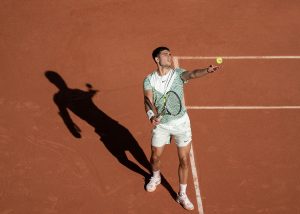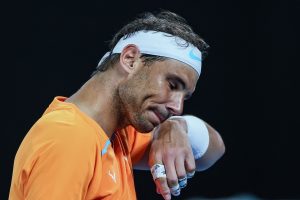As the Coronavirus crisis continues to prevent any elite professional tennis from being played, one of the few ways in which tennis lovers can indulge their obsession is to stage imaginary tennis matches in their mind, pitting the greatest champions of the past against the greatest contemporary players. In particular, fans of men’s tennis might speculate on how the likes of Tilden, Perry and Emerson would fare against today’s “Big Three” (Gigantic Three would be more accurate) of Federer, Nadal and Djokovic. However, there is one of these matches that is surely more enticing to imagine than any other, namely any one of the Big Three on the lawns of Wimbledon against the man who is almost universally regarded as the greatest grass-court player in the history of tennis, Pete Sampras.
Even today, nearly 20 years after he retired, Sampras is still often referred to as “Pistol Pete”, the alliterative nickname that was a testament to the sheer power and accuracy that he possessed, particularly in the two most important components of his game (which were once the two most important components of any tennis player’s game), serve and volley. However, “Pistol Pete” was, as it were, a double nickname, in that Pete Sampras was really Petros Sampras, the son of Greek-Americans, who was born in Washington D.C. on 12 August 1971.
Just like the man who is probably his greatest rival for the title of the greatest American male tennis player ever, John McEnroe, Sampras’s idol and inspiration as a young tennis player was another man with an alliterative nickname, “Rocket Rod” Laver, even though, unlike McEnroe, Sampras was too young to have grown up watching the great Australian play live. However, he compensated by devouring any footage he could find of Laver and, rather more incredibly, at the tender age of 11 he was lucky enough to meet and actually play Laver, an event that in retrospect can be regarded as a truly historic passing of the baton, or at least the racket, from one great grass-court player to another.
Sampras, undoubtedly emboldened by that early meeting and match with the legendary Laver, was a child champion who turned professional at the extremely young age of 16, in 1988. His rise up the rankings was almost vertiginous, because by the end of that year he was ranked within the men’s top 100. And if anything, the pace of his development only accelerated over the next few seasons, such that by 1990, just two years after turning professional, he won his first Major title, the US Open, when he was only 19 years old.
Even now, nearly thirty years on from that spectacular breakthrough victory, the roll-call of Sampras’s victims en route to winning his first Major is so impressive that that victory is arguably the impressive debut Slam win in men’s tennis history. In his last three matches alone, he defeated Ivan Lendl in the quarter-final (snapping Lendl’s remarkable streak of reaching eight successive US Open Finals), John McEnroe in the semi-final (McEnroe, of course, was a four-time champion in New York), and then, lest anyone suggest that he was only capable of beating up old guys, he demolished the man who was generally regarded as the next Major champion in waiting, Andre Agassi, in straight sets in the Final. Sampras had arrived, and in extraordinary style.
It is what followed next, after that maiden Major victory, that is so interesting now, three decades on, when it can be easy to regard Sampras’s rise to the top of tennis (not only in his own era but historically) as almost effortless. Like so many champions in so many sports, Sampras soon discovered that it was one thing to reach the top but quite another to stay there. It was not as if he fell off a cliff form-wise – far from it, as he continued to reach semi-finals and even finals – but he certainly did not instantly build upon that initial US Open triumph, as many commentators and even many of his fellow players had expected.
Instead, he struggled, at least relative to his early success, culminating in his quarter-final loss at the 1991 US Open to another young and upcoming American, Jim Courier. Then, even more incredibly, he claimed that he was actually relieved not to have made another Final, as it meant that he no longer had the pressure of being a defending champion.
https://www.youtube.com/watch?v=_hQwHxk8lqM
It is almost impossible to square that comment, and the attitude it betrayed, with the relentless winning machine that Sampras would subsequently become, especially on grass. However, his relative malaise continued for another year. Although he made it to another US Open Final in 1992, he was fairly soundly beaten in four sets by the man who he would eventually replace as the greatest serve-volleyer in tennis, Stefan Edberg.
That loss to Edberg, two years after he had first broken through at the highest level by winning the same tournament, proved to be the turning-point in Sampras’s career. Like a recovering alcoholic (or at least a “champion-a-holic”, who was addicted to winning), he claimed afterwards that it was a “wake-up” call for him, and that he subsequently learned from Edberg and the other great champions of the era, such as Lendl and Boris Becker, exactly what was required to be not just a one-off Major winner but a consistent Major winner and even, in time, a World No.1.
https://www.youtube.com/watch?v=VNLdLMo5f_g
Thus began what is arguably the greatest single decade of any male tennis player ever and certainly the greatest single decade of any male tennis player on grass, the surface the game originated on and the one that for for most tennis players, writers and fans remains the greatest surface on which to play, precisely because it is the fastest and most unpredictable. Even the most imperious phase in Roger Federer’s generally imperious career, between 2003 and 2007, when he won five successive Wimbledon titles and seven other Major titles (three in Australia and four in New York), only lasted half a decade, whereas it is safe to say that if ever a male tennis player owned Wimbledon, in the sense of completely dominating it, it was Pete Sampras in the 1990s.
In total, Sampras lost just one match at Wimbledon between his first triumph in 1993 and his final triumph in 2000, seven calendar years and eight editions of the tournament later. That solitary loss came in 1996, when, having already won a hat-trick of Wimbledon titles, he lost to Holland’s Richard Krajicek, after Krajicek had produced not only a serving performance for the ages but actually managed to achieve what had come to be thought impossible, namely breaking Sampras’s serve on grass, not once but twice, as he won in straight sets, 7-5, 7-6(7–3), 6-4. But then, as if personally affronted by that against-all-odds defeat, Sampras doubled down on his previous dominance by winning the next four Wimbledon titles, to make it a truly magnificent seven out of eight Wimbledon wins.
The irony is that so complete was Sampras’s dominance on grass, on which his second serve (traditionally the most important shot on grass) was undoubtedly the greatest in the history of tennis, that his achievements at the other Majors, considerable as they were, almost paled into insignificance. And yet in the 1990s he won another three US Opens (in 1993, 1995 and 1996) and two Australian Opens (in 1994 and 1997). Even more impressively, between 1993 and 1998 he ended the season as World No.1 for an Open-era record six successive seasons in a row, which even Federer, Nadal and Djokovic have not matched, let alone bettered.
It was only on the clay of Paris that Sampras exhibited, as it were, clay feet. Not only did he fail to win a French Open but he never even reached a Final, on the surface that, in its relative slowness, was antithetical to his all-action, all-power, ultra-fast serve-and-volley game. The closest he came was in 1996, when he reached the semi-final, but even then he lost limply to Russia’s Yefgeny Kafelnikov, the eventual champion, in straight sets, 6-7, 0-6, 2-6. And yes, that is a big fat bagel (or zero) in the middle there.
https://www.youtube.com/watch?v=12TDpELvHQQ
It is that failure to become an all-surface champion that is the biggest stick used to beat Sampras down when it comes to considering who is the greatest player of all time. The other two attacks that were most commonly made upon him were that, one, he lacked a rival, especially on grass, capable of challenging him consistently and thereby pushing him to even greater heights and, two, that he was so good on grass that he almost made the game boring. The first of those criticisms can simply be dismissed, as it was not Sampras’s fault that, unlike Bjorn Borg or Roger Federer, he lacked a John McEnroe or Rafael Nadal to test him to and even beyond the limit of his ability. And the second is actually the ultimate compliment, because on grass in the 1990s Sampras was one of those rarest of sports men or women, or even sports teams, who are so good that they almost make the game they play look too easy. He has very few real rivals in that regard, such as the great West Indian cricket team of the 1970s and 1980s, or the Real Madrid football team that won the first five European Cups in succession.
It is in that context of his previous dominance that makes the end of Sampras’s career so fascinating, as he finally returned to the relative vulnerability that had marked the start of his career after that initial US Open triumph. The first sign of the waning of his powers was the 2000 US Open Final loss to Marat Safin, when the young and bull-like Russian blasted him off court in straight sets and looked like his heir apparent as the next dominant World No.1 in the men’s game (when, in reality, Safin would only ever win one more Major, five years later in Melbourne). Similarly, a year later Sampras also lost the US Open Final to Lleyton Hewitt in straight sets. Indeed, that defeat was even more devastating, as Sampras, who had previously been almost as all-conquering on hardcourt as he was on grass, won only a single game in each of the last two sets.
However, it was at Wimbledon at the start of the new millennium (a phrase that, like so much else now, seems utterly antiquated in our new age of panic and pandemic) that Sampras’s decline seemed most stark. It was one thing to lose to Roger Federer in the fourth round in 2001, because even then the young Swiss had been identified as a potential Major-winner (if not yet as a contender for the title of the greatest male player ever). However, it was quite another to lose to the unheralded George Bastl in the second round in 2002, as Bastl’s only real point of comparison with Federer was that they were both Swiss.
Consequently, it seemed in the late summer and early autumn of 2002 that the great Pete Sampras was all washed up with nowhere to go. But then came what remains, nearly two decades on, probably the greatest last-gasp win in tennis history. More than two years on from his last Major win, which had come at Wimbledon in 2000, Sampras somehow summoned up the last of his incredible fighting spirit, first to reach the US Open Final again (a dozen years on from his first appearance) and then to win it in four sets against the man who was his closest (but still fairly distant) rival throughout his career, Andre Agassi.
It was a swansong that was not only comparable with the finest in sport, such as the ageing Muhammad Ali winning the World Heavyweight Championship title for a third time in 1978, but comparable with any in any other field of human endeavour, such as those of Bowie or Beethoven in music, when they railed against the dying of their once undimmable light by producing work comparable with, or arguably even greater than, the masterpieces they had produced in their youth.
Sampras did not retire immediately after winning the 2002 US Open. However, he never set foot on a tennis court as a professional again, finally announcing (or, more accurately, confirming) his retirement the following summer. And in a sense, that somewhat complex retirement is in keeping with his somewhat complex legacy as a tennis player.
That is because Sampras was not only arguably the greatest serve-volleyer in the history of tennis but he was also almost certainly the last great serve-volleyer in the history of tennis. As William Skidelsky outlines in his magisterial book, Federer and Me, the developments in tennis technology – that is to say, specifically the use of non-wooden rackets – from the 1980s onwards have almost made serve-volleying obsolete, because the much larger sweet spot of non-wooden rackets has revolutionised returning, making it almost impossible for a player to come to the net and not be passed regularly. As a result, although Sampras’s record of 14 Major victories has now been surpassed by all of today’s Big Three, he will probably always be regarded as the greatest serve-volleyer in the history of tennis.
Main Photo:






